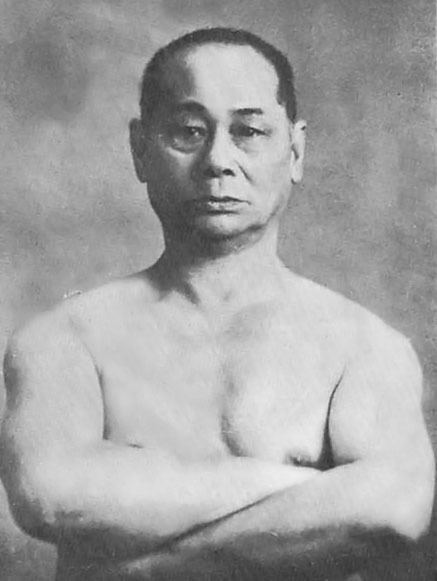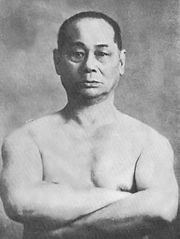Name Motobu Choki | ||
 | ||
Born April 5, 1870Akahira Village, Shuri, Ryukyu Kingdom ( 1870-04-05 ) Died April 15, 1944(1944-04-15) (aged 74)Shuri, Japan Rank Soke, Founder of Motobu-ryu Notable students His son Chosei Motobu, Tatsuo Yamada, Sannosuke Ueshima, Yasuhiro Konishi, Hironori Otsuka, Tatsuo Shimabuku, Shoshin Nagamine, Katsuya Miyahira Website Motobu-ryu Okinawan Karate and World Peace The Hawaii Karate Seinenkai Salutes: Shoshin Nagamine Techniques of the Masters: Shoshin Nagamine Akari-ki Karate: Nagamine Shugyokan Shorin Ryu Dojo“Karate Ni Sente Nashi” a la Motobu Choki | ||
Motobu Chōki (本部 朝基, 1870-1944) was an Okinawan karateka from Akahira Village in Shuri, Okinawa, capital of the Ryūkyū Kingdom when he was born. His older brother Motobu Chōyū was also a noted karateka.
Contents

His father, Lord Motobu Chōshin (Motobu Aji Chōsin) was a descendant of the sixth son of the Okinawan King, Shō Shitsu (1629–1668), namely Shō Kōshin, also known as Prince Motobu Chōhei (1655–1687). Chōki was the third son of Motobu Udun ("Motobu Palace"), one of the cadet branches of the Ryūkyūan royal family.
As the last of three sons, Motobu Chōki was not entitled to an education in his family's style of Te (an earlier name for karate). Despite this Motobu was very interested in the art, spending much of his youth training on his own, hitting the makiwara, pushing and lifting heavy stones to increase his strength. He is reported to have been very agile, which gained him the nickname Motobu no Saru, or "Motobu the Monkey." He began practicing karate under Matsumura Sōkon and continued under Ankō Itosu, Sakuma Pechin and Kōsaku Matsumora.
Training and career
Although he was reputed by his detractors to have been a violent and crude street fighter, with no formal training, Motobu was a student of several of Okinawa's most prominent karate practitioners. Ankō Itosu (1831–1915), Sōkon Matsumura (1809–1899), Sakuma Pechin, Kōsaku Matsumora (1829–1898), and Tokumine Pechin (1860–1910) all taught Motobu at one time or another. Many teachers found his habit of testing his fighting prowess via street fights in the tsuji (red light district) undesirable, but his noble birth (as a descendant of the royal Okinawan Shō family) may have made it hard for them to refuse.
Popular myth holds that Motobu only knew one kata, Naifanchi (Naihanchi). Although he favored this kata, and called it "the fundamental of karate," he also made comments on the practice of Passai, Chintō, and Rōhai. Other sources describe Sanchin, Kusanku, and Ueseishi as having been part of his repertoire. He apparently developed his own kata, Shiro Kuma (White Bear). Motobu lived and taught karate in Japan until 1942, when he returned to Okinawa, dying shortly thereafter. Prior to this, he had made several trips there to study orthodox kata and kobudō in an effort to preserve the traditional forms of the art.
The boxing match
After a number of failed business enterprises, Motobu moved to Osaka, Japan, in 1921. A friend convinced Motobu to enter a "boxing vs judo" match which was taking place. These matches were popular at the time, and often pitted a visiting foreign boxer against a jujutsu or judo man. According to an account of the fight from a 1925 King magazine article, Motobu is said to have entered into a challenge match with a foreign boxer, described as a Russian boxer or strongman. Early rounds involved evasion by the smaller man, but after a few rounds, according to the account, Motobu moved in on the taller, larger boxer and knocked him out with a single hand strike to the head. Since reporters were not familiar with karate at that time, it is also possible that Motobu kicked the taller man in the groin to enable striking the head. Motobu was then 52 years old.
The King article detailed Motobu's surprising victory, although the illustrations clearly show Gichin Funakoshi as the Okinawan fighter in question. This publication error increased the bitter rivalry between the two men, and led to an apparent confrontation. The two were often at odds in their opinions about how karate ought to be taught and used.
The popularity generated by this unexpected victory propelled both Motobu and karate to a degree of fame that neither had previously known in Japan. Motobu was petitioned by several prominent individuals, including boxing champ "Piston" Horiguchi, to begin teaching. He opened a dojo, the Daidokan, where he taught until the onset of World War II in 1941. Motobu faced considerable difficulties in his teaching. Chief among those was his inability to read and speak mainland Japanese. As a result, much of his instruction was through translators, which led to the rumor that he was illiterate. This rumor has been largely discredited by the existence of samples of Motobu's handwriting, which is in a clear and literate hand. In a Tsunami video production on the Motobu style, Motobu Chōsei comments that his father's language difficulties may have been motivated more by protest at being a displaced member (by the Japanese annexation of Okinawa) of the Ryukyuan aristocracy than by inability.
Motobu's legacy and notable students
Motobu Chōki's third son, Chōsei Motobu (1925- ), still teaches the style that his father passed on to him. As a point of reference, it is important to distinguish between the "Motobu-ryū" which Chōsei teaches, and "Motobu Udun Di", the unique style of the Motobu family, which bears a resemblance to aikijutsu. Now Chōsei Motobu is the second Sōke of Motobu-ryū and the 14th Sōke of Motobu Udun Di.
Motobu's karate is marked by a series of two man kumite drills, which were an advancement in the popular thinking and instructional methods of the time. His curriculum heavily favored the Naihanchi kata because of the correspondence between its applications (bunkai) and actual fighting, which he experienced in brawls as a young man. Below are some of his ideas regarding the 'kata:
Motobu trained many students who went on to become noteworthy practitioners of karate in their own right, including:
Motobu published two books on karate, Okinawa Kenpo Karate-jutsu Kumite-hen (1926) and Watashi no Karate Jutsu (1933. Available in translation by Patrick and Yuriko McCarthy).
